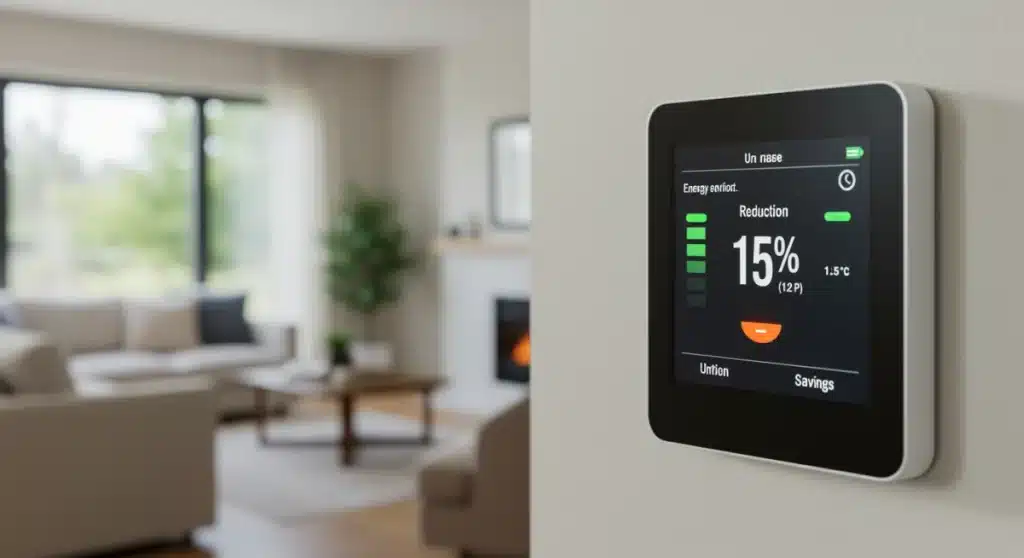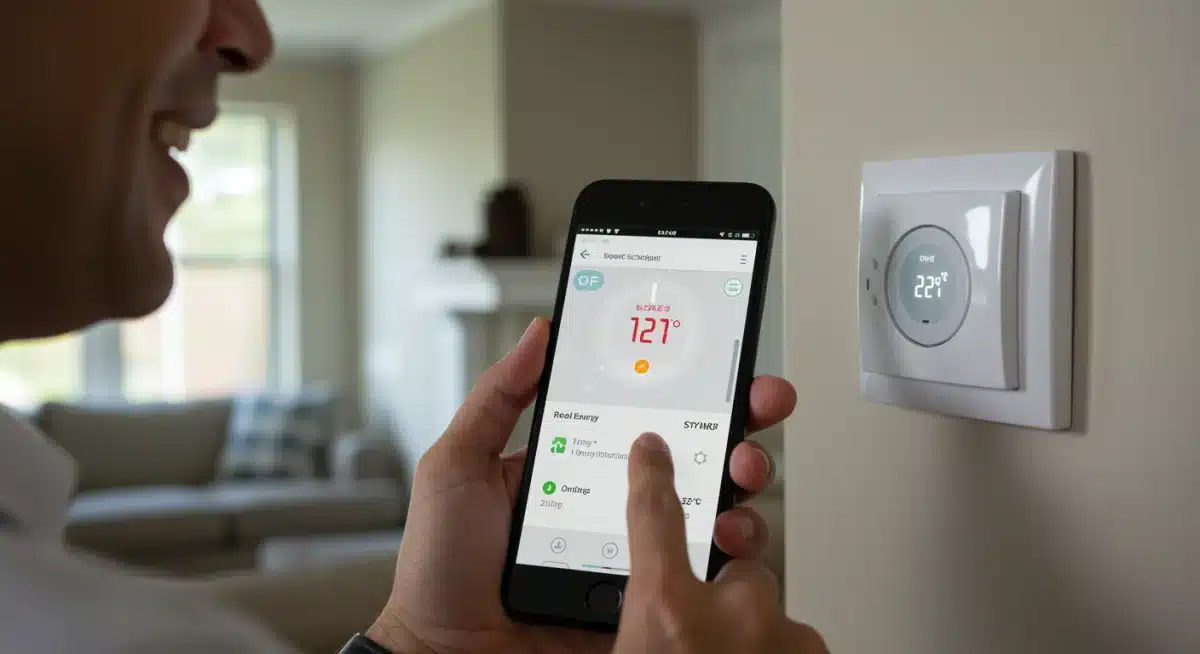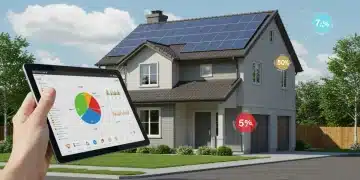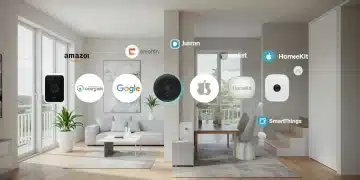Maximizing Energy Savings: Smart Thermostats Cut US Home Bills by 15%

Smart thermostats are proving to be a game-changer for homeowners across the US, consistently delivering an average of 15% reduction in utility bills through intelligent energy management and automation, translating into substantial financial savings.
The quest for lower utility bills and a more sustainable lifestyle has led many American homeowners to embrace smart home technology. At the forefront of this movement is the smart thermostat, a device now demonstrably linked to
Maximizing Energy Savings: How Smart Thermostats Cut Utility Bills by 15% in US Homes (FINANCIAL IMPACT).
Recent data confirms these intelligent devices are not just a convenience but a powerful tool for significant financial relief and environmental stewardship.
The Rise of Smart Thermostats in US Homes
The adoption of smart thermostats has accelerated rapidly across the United States. Driven by advancements in IoT (Internet of Things) technology and increasing consumer awareness of energy consumption, these devices have transitioned from niche gadgets to mainstream household essentials. This widespread integration is directly contributing to the significant financial impact seen in utility bill reductions.
Recent market analyses indicate that millions of US households have already installed smart thermostats, with projections showing continued growth. This trend is fueled by their promise of convenience, control, and, most importantly, demonstrable savings. Homeowners are increasingly prioritizing solutions that offer both comfort and economic benefits, making smart thermostats an attractive investment.
Technological Advancements Driving Adoption
- AI and Machine Learning: Modern smart thermostats learn household routines and adjust temperatures automatically, optimizing energy use without constant manual input.
- Geofencing Capabilities: Many devices can detect when residents leave or return home, adjusting heating or cooling to save energy when the house is empty.
- Integration with Smart Home Ecosystems: Seamless connectivity with other smart devices and voice assistants enhances user experience and overall home automation.
Understanding the 15% Utility Bill Reduction
The reported 15% reduction in utility bills is not an arbitrary figure but an average derived from extensive studies and real-world usage data. This substantial saving primarily stems from the smart thermostat’s ability to precisely manage heating and cooling, which typically accounts for the largest portion of a household’s energy consumption. By eliminating wasteful energy use, these devices offer a tangible financial return.
Energy companies and independent research organizations have consistently validated these savings. For instance, studies by the American Council for an Energy-Efficient Economy (ACEEE) and major smart thermostat manufacturers themselves have shown that programmable and learning thermostats can lead to double-digit percentage savings on energy costs. This makes the investment in a smart thermostat a financially prudent decision for many homeowners.
How Smart Thermostats Achieve Savings
- Automated Scheduling: Smart thermostats allow for detailed programming, ensuring heating and cooling only operate when needed, aligning with daily routines.
- Remote Control: Users can adjust settings from anywhere via a smartphone, preventing energy waste if plans change unexpectedly.
- Energy Usage Reports: Many models provide detailed insights into energy consumption, empowering homeowners to identify and correct inefficient habits.
- System Diagnostics: Some advanced thermostats can monitor HVAC system performance, alerting users to potential issues that could lead to increased energy use.
Financial Impact for US Homeowners
For the average US household, a 15% reduction in utility bills translates into significant annual savings. With the fluctuating costs of electricity and natural gas, these savings provide a much-needed buffer against rising living expenses. The initial investment in a smart thermostat is often recouped within a year or two, making it a compelling financial decision for many.
Consider a typical American home with an annual energy bill of $2,000; a 15% reduction would save them $300 per year. Over five years, this amounts to $1,500, often exceeding the cost of the device and its installation. This long-term financial benefit makes smart thermostats an attractive upgrade for budget-conscious consumers.
Beyond Direct Savings: Rebates and Incentives
Many utility companies and local governments offer rebates and incentives for installing smart thermostats. These programs are designed to encourage energy efficiency and reduce strain on power grids. Homeowners should investigate available programs in their area, as these can further reduce the upfront cost, making the return on investment even faster.
For example, some states offer tax credits, while specific utility providers might provide instant rebates at the point of purchase or through a direct application process. These incentives underscore the broader societal benefit of widespread smart thermostat adoption, moving beyond individual financial gains to collective energy conservation goals.

Environmental Benefits and Sustainability
Beyond the immediate financial gains for individual homeowners, the widespread adoption of smart thermostats carries substantial environmental benefits. By optimizing energy consumption, these devices contribute to a significant reduction in overall carbon emissions. Less energy demand means less reliance on fossil fuel-based power generation, directly supporting sustainability efforts.
The cumulative effect of millions of homes reducing their energy footprint by 15% is immense. This collective action helps mitigate climate change, conserves natural resources, and promotes a greener future. Smart thermostats are therefore not just a personal convenience but a tool for broader ecological responsibility.
Contribution to Grid Stability
- Demand Response Programs: Many smart thermostats can participate in utility demand response programs, allowing utilities to subtly adjust temperatures during peak demand times to prevent blackouts and reduce strain on the electrical grid.
- Reduced Peak Load: By intelligently pre-cooling or pre-heating homes, smart thermostats can shift energy usage away from peak hours, making the grid more efficient and stable.
Choosing the Right Smart Thermostat
With a growing number of smart thermostat options available, selecting the right device can seem daunting. Key factors to consider include compatibility with existing HVAC systems, desired features, integration with other smart home devices, and budget. Understanding these elements will help homeowners make an informed decision that maximizes their energy savings and comfort.
Popular brands like Nest, Ecobee, and Honeywell offer a range of models, each with unique capabilities. Some prioritize learning algorithms, while others focus on extensive sensor networks or advanced zoning controls. Researching reviews and comparing features against personal needs is crucial for optimal selection.
Key Features to Look For
- Learning Capabilities: Automatically adjusts to your schedule and preferences over time.
- Remote Access: Control your thermostat from anywhere via a mobile app.
- Geofencing: Detects when you’re home or away to save energy.
- Zoning Compatibility: If you have multiple heating/cooling zones, ensure the thermostat supports this.
- Energy Reporting: Provides insights into your energy consumption patterns.
- Voice Assistant Integration: For seamless control with devices like Amazon Alexa or Google Assistant.
Installation and Setup Considerations
While many smart thermostats are designed for DIY installation, some homeowners may prefer professional assistance, especially if their HVAC system is older or more complex. Proper installation is critical to ensure the device functions optimally and delivers the promised energy savings. Most manufacturers provide clear instructions and online resources to guide users through the process.
Before purchasing, it’s wise to check your existing wiring (C-wire compatibility is a common requirement) and ensure the new thermostat is compatible with your heating and cooling system. A smooth setup process will get you started on your path to Maximizing Energy Savings: How Smart Thermostats Cut Utility Bills by 15% in US Homes (FINANCIAL IMPACT) without unnecessary delays.
Ensuring Optimal Performance
- C-Wire Check: Verify if your current thermostat wiring includes a C-wire (common wire), which provides continuous power to smart thermostats. Adapters are available if not.
- HVAC Compatibility: Confirm the smart thermostat is compatible with your specific heating and cooling system (e.g., conventional, heat pump, multi-stage).
- Wi-Fi Connectivity: Ensure a stable 2.4 GHz Wi-Fi network is available for seamless operation and remote access.
| Key Point | Brief Description |
|---|---|
| Utility Bill Reduction | Smart thermostats cut average US home utility bills by 15% through optimized heating and cooling. |
| Financial Impact | Significant annual savings for homeowners, with often quick return on investment for the device. |
| Environmental Benefits | Reduced carbon emissions and support for grid stability through efficient energy management. |
| Key Features | Learning capabilities, remote access, geofencing, and energy reporting are crucial for maximizing savings. |
Frequently Asked Questions About Smart Thermostats
On average, US homeowners can expect to save about 10-15% on their heating and cooling costs, which typically accounts for roughly half of a household’s total energy bill. This translates to hundreds of dollars in savings annually, depending on your home’s size and local climate.
Most smart thermostats are designed for DIY installation, with clear instructions provided. However, compatibility with your existing HVAC system and wiring (especially a C-wire) is crucial. If you’re unsure, professional installation is recommended to ensure proper function and safety.
Yes, many advanced smart thermostats use machine learning algorithms to observe your habits over time. They learn when you’re home, when you’re away, and your preferred temperatures, then automatically create an optimized schedule to maximize comfort and energy savings.
Beyond financial savings, smart thermostats offer enhanced convenience through remote control, improved comfort with precise temperature management, environmental benefits by reducing carbon footprint, and often provide valuable insights into your home’s energy consumption patterns.
Absolutely. Many utility companies, state governments, and local municipalities offer rebates, tax credits, or other incentives to encourage the adoption of energy-efficient smart thermostats. Check with your local utility provider and state energy office for available programs in your area.
Looking Ahead: The Evolving Role of Smart Energy Management
The demonstrated capacity for Maximizing Energy Savings: How Smart Thermostats Cut Utility Bills by 15% in US Homes (FINANCIAL IMPACT) positions these devices as central to the future of residential energy management. As technology continues to evolve, we can anticipate even greater integration with broader smart grid initiatives and artificial intelligence, leading to further optimized energy consumption. Expect to see smart thermostats playing a more active role in personalized energy profiles and proactive maintenance alerts for HVAC systems. This ongoing evolution will not only deepen financial savings for homeowners but also strengthen the resilience and sustainability of national energy infrastructure, marking a critical step towards a truly smart and energy-efficient future.





